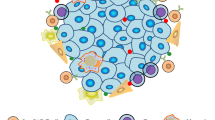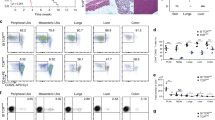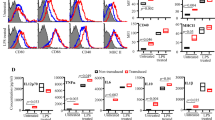Abstract
Since the discovery of T cells that express two T cell receptors (TCRs), termed dual TCR cells, most studies have focused on their autoimmune potential, while their beneficial roles remained elusive. We identified, in normal mice, dual TCR cells that participated in the immune response to a foreign antigen. Unlike single TCR cells, dual TCR cells used the nonselected TCR to respond in the periphery, but relied on coexpression of a second TCR for intrathymic selection. We found that they were selected at low frequency in the naïve repertoire, but dominated the response to antigen through clonal expansion. Thus, dual TCR cells can extend the TCR repertoire for foreign antigens by rescuing functional TCRs that cannot be selected on single TCR cells; they can, therefore, benefit the immune system.
This is a preview of subscription content, access via your institution
Access options
Subscribe to this journal
Receive 12 print issues and online access
$209.00 per year
only $17.42 per issue
Buy this article
- Purchase on Springer Link
- Instant access to full article PDF
Prices may be subject to local taxes which are calculated during checkout







Similar content being viewed by others
References
Burnet, F. M. The clonal selection theory of acquired immunity (Vanderbilt University Press, Nashville, TN, 1959).
Casanova, J. L., Romero, P., Widmann, C., Kourilsky, P. & Maryanski, J. L. T cell receptor genes in a series of class I major histocompatibility complex-restricted cytotoxic T lymphocyte clones specific for a Plasmodium berghei nonapeptide: implications for T cell allelic exclusion and antigen-specific repertoire. J. Exp. Med. 174, 1371–1383 (1991).
Padovan, E. et al. Expression of two T cell receptor α chains: dual receptor T cells. Science 262, 422–424 (1993).
Heath, W. R. et al. Expression of two T cell receptor α chains on the surface of normal murine T cells. Eur. J. Immunol. 25, 1617–1623 (1995).
Elliott, J. I. Selection of dual Vα T cells. Eur. J. Immunol. 28, 2115–2123 (1998).
Alam, S. M. & Gascoigne, N. R. Posttranslational regulation of TCR Vα allelic exclusion during T cell differentiation. J. Immunol. 160, 3883–3890 (1998).
Davodeau, F. et al. Dual T cell receptor β chain expression on human T lymphocytes. J. Exp. Med. 181, 1391–1398 (1995).
Padovan, E. et al. Normal T lymphocytes can express two different T cell receptor β chains: implications for the mechanism of allelic exclusion. J. Exp. Med. 181, 1587–1591 (1995).
Balomenos, D. et al. Incomplete T cell receptor Vβ allelic exclusion and dual Vβ- expressing cells. J. Immunol. 155, 3308–3312 (1995).
Borgulya, P., Kishi, H., Uematsu, Y. & von Boehmer, H. Exclusion and inclusion of α and β T cell receptor alleles. Cell 69, 529–537 (1992).
Brandle, D., Muller, C., Rulicke, T., Hengartner, H. & Pircher, H. Engagement of the T-cell receptor during positive selection in the thymus down-regulates RAG-1 expression. Proc. Natl Acad. Sci. USA 89, 9529–9533 (1992).
Kouskoff, V., Vonesch, J. L., Benoist, C. & Mathis, D. The influence of positive selection on RAG expression in thymocytes. Eur. J. Immunol. 25, 54–58 (1995).
Petrie, H. T. et al. Multiple rearrangements in T cell receptor α chain genes maximize the production of useful thymocytes. J. Exp. Med. 178, 615–622 (1993).
Padovan, E., Casorati, G., Dellabona, P., Giachino, C. & Lanzavecchia, A. Dual receptor T-cells. Implications for alloreactivity and autoimmunity. Ann. NY Acad. Sci. 756, 66–70 (1995).
Sarukhan, A., Garcia, C., Lanoue, A. & von Boehmer, H. Allelic inclusion of T cell receptor α genes poses an autoimmune hazard due to low-level expression of autospecific receptors. Immunity 8, 563–570 (1998).
Zal, T., Weiss, S., Mellor, A. & Stockinger, B. Expression of a second receptor rescues self-specific T cells from thymic deletion and allows activation of autoreactive effector function. Proc. Natl Acad. Sci. USA 93, 9102–9107 (1996).
Fossati, G., Cooke, A., Papafio, R. Q., Haskins, K. & Stockinger, B. Triggering a second T cell receptor on diabetogenic T cells can prevent induction of diabetes. J. Exp. Med. 190, 577–583 (1999).
Elliott, J. I. & Altmann, D. M. Dual T cell receptor α chain T cells in autoimmunity. J. Exp. Med. 182, 953–959 (1995).
Elliott, J. I. & Altmann, D. M. Nonobese diabetic mice hemizygous at the T cell receptor α locus are susceptible to diabetes and sialitis. Eur. J. Immunol. 26, 953–956 (1996).
Hardardottir, F., Baron, J. L. & Janeway, C. A. T cells with two functional antigen-specific receptors. Proc. Natl Acad. Sci. USA 92, 354–358 (1995).
Murray, J. S., Pfeiffer, C., Madri, J. & Bottomly, K. Major histocompatibility complex (MHC) control of CD4 T cell subset activation. II. A single peptide induces either humoral or cell- mediated responses in mice of distinct MHC genotype. Eur. J. Immunol. 22, 559–565 (1992).
Constant, S. L. & Bottomly, K. Induction of Th1 and Th2 CD4+ T cell responses: the alternative approaches. Annu. Rev. Immunol. 15, 297–322 (1997).
Malissen, B. & Malissen, M. in T cell receptors (eds Bell, J. I., Owen, M. J. & Simpson, E.) 352–365 (Oxford University Press, Oxford, 1995).
Lucas, B. & Germain, R. N. Unexpectedly complex regulation of CD4/CD8 coreceptor expression supports a revised model for CD4+CD8+ thymocyte differentiation. Immunity 5, 461–477 (1996).
Sant'Angelo, D. B. et al. A molecular map of T cell development. Immunity 9, 179–186 (1998).
Lyons, A. B. & Parish, C. R. Determination of lymphocyte division by flow cytometry. J. Immunol. Meth. 171, 131–137 (1994).
Lee, W. T. & Pelletier, W. J. Visualizing memory phenotype development after in vitro stimulation of CD4(+) T cells. Cell. Immunol. 188, 1–11 (1998).
Suchin, E. J. et al. Quantifying the frequency of alloreactive T cells in vivo: new answers to an old question. J. Immunol. 166, 973–981 (2001).
Janeway, C. Immunobiology: the immune system in health and disease (Current Biology Publications/Garland Publishers, London & New York, 1999).
Jorgensen, J. L., Esser, U., Fazekas de St. Groth, B., Reay, P. A. & Davis, M. M. Mapping T-cell receptor-peptide contacts by variant peptide immunization of single-chain transgenics. Nature 355, 224–230 (1992).
Sant'Angelo, D. B. et al. The imprint of intrathymic self-peptides on the mature T cell receptor repertoire. Immunity 7, 517–524 (1997).
Fukui, Y. et al. Highly restricted T cell repertoire shaped by a single major histocompatibility complex-peptide ligand in the presence of a single rearranged T cell receptor β chain. J. Exp. Med. 188, 897–907 (1998).
Ridgway, W., Fasso, M. & Fathman, C. G. Following antigen challenge, T cells up-regulate cell surface expression of CD4 in vitro and in vivo. J. Immunol. 161, 714–720 (1998).
Mason, D. Allelic exclusion of α chains in TCRs. Int. Immunol. 6, 881–885 (1994).
Fasso, M. et al. T cell receptor (TCR)-mediated repertoire selection and loss of TCR Vβ diversity during the initiation of a CD4(+) T cell response in vivo. J. Exp. Med. 192, 1719–1730 (2000).
McHeyzer-Williams, L. J., Panus, J. F., Mikszta, J. A. & McHeyzer-Williams, M. G. Evolution of antigen-specific T cell receptors in vivo: preimmune and antigen-driven selection of preferred complementarity-determining region 3 (CDR3) motifs. J. Exp. Med. 189, 1823–1838 (1999).
Grubin, C. E., Kovats, S., deRoos, P. & Rudensky, A. Y. Deficient positive selection of CD4 T cells in mice displaying altered repertoires of MHC class II-bound self-peptides. Immunity 7, 197–208 (1997).
Surh, C. D., Lee, D. S., Fung-Leung, W. P., Karlsson, L. & Sprent, J. Thymic selection by a single MHC/peptide ligand produces a semidiverse repertoire of CD4+ T cells. Immunity 7, 209–219 (1997).
Barton, G. M. & Rudensky, A. Y. Requirement for diverse, low-abundance peptides in positive selection of T cells. Science 283, 67–70 (1999).
Ignatowicz, L. et al. T cells can be activated by peptides that are unrelated in sequence to their selecting peptide. Immunity 7, 179–186 (1997).
Kraj, P., Pacholczyk, R. & Ignatowicz, L. αβ TCRs differ in the degree of their specificity for the positively selecting MHC/peptide ligand. J. Immunol. 166, 2251–2259 (2001).
Kersh, G. J. et al. TCR transgenic mice in which usage of transgenic α- and β-chains is highly dependent on the level of selecting ligand. J. Immunol. 161, 585–593 (1998).
Wong, P., Goldrath, A. W. & Rudensky, A. Y. Competition for specific intrathymic ligands limits positive selection in a TCR transgenic model of CD4+ T cell development. J. Immunol. 164, 6252–6259 (2000).
Simpson, E., Chandler, P., Sponaas, A., Millrain, M. & Dyson, P. J. T cells with dual antigen specificity in T cell receptor transgenic mice rejecting allografts. Eur. J. Immunol. 25, 2813–2817 (1995).
Lee, W. T., Shiledar-Baxi, V., Winslow, G. M., Mix, D. & Murphy, D. B. Self-restricted dual receptor memory T cells. J. Immunol. 161, 4513–4519 (1998).
Kouskoff, V., Signorelli, K., Benoist, C. & Mathis, D. Cassette vectors directing expression of T cell receptor genes in transgenic mice. J. Immunol. Meth. 180, 273–280 (1995).
Harrington, C. J. et al. Differential tolerance is induced in T cells recognizing distinct epitopes of myelin basic protein. Immunity 8, 571–580 (1998).
Viret, C., Lantz, O., He, X., Bendelac, A. & Janeway, C. A. A NK1.1+ thymocyte-derived TCR β-chain transgene promotes positive selection of thymic NK1.1+ α β T cells. J. Immunol. 165, 3004–3014 (2000).
Viret, C., Wong, F. S. & Janeway, C. A. Jr Designing and maintaining the mature TCR repertoire: the continuum of self-peptide:self-MHC complex recognition. Immunity 10, 559–568 (1999).
Sant'Angelo, D. B. et al. The specificity and orientation of a TCR to its peptide-MHC class II ligands. Immunity 4, 367–376 (1996).
Acknowledgements
We thank N. Crispe for critical comments on the manuscript; D. Sant'Angelo for advice; G. Losyev for help on screening mice; D. Mathis and C. Benoist for pTα and pTβ cassette vectors. Supported in part by NIH grants (AI-26791, CA-28250 to K. B., and AI-14579 to C. J.), and by the Howard Hughes Medical Institute.
Author information
Authors and Affiliations
Corresponding author
Ethics declarations
Competing interests
The authors declare no competing financial interests.
Supplementary information
Web Figure 1.
KB TCR is not positively selected in the αTg×KB RAG-1−/− thymus. The αTg was derived from the T cell hybrid T200.4E. The αTg×KB RAG-1−/− thymus was from mice that expressed both the αTg and the KB αβTCR on the RAG-1−/− background. Coexpression of the second αTg will reduce the expression level of KB TCR. We found no positive selection in the thymus: lack of CD4 single positive T cells (<1%); no mature CD4+ cells (<1%) in Vβ8hi-gated post-selection thymocytes; and a normal number of total thymocytes (75×106 cells) with majority being the immature CD4+CD8+ cells (82%). CD4 and CD8 distributions are shown as a dot-plot without (left) and with (right) electronic gating on Vβ8hi thymocytes. The expression of the KB TCRβ chain (Vβ8) is shown as a histogram. Single-cell suspensions of the thymus were triple stained for CD4, CD8 and Vβ8. The profiles are representative of two experiments. (GIF 16 kb)
Rights and permissions
About this article
Cite this article
He, X., Janeway, C., Levine, M. et al. Dual receptor T cells extend the immune repertoire for foreign antigens. Nat Immunol 3, 127–134 (2002). https://doi.org/10.1038/ni751
Received:
Accepted:
Published:
Issue Date:
DOI: https://doi.org/10.1038/ni751
This article is cited by
-
Viral infection triggers central nervous system autoimmunity via activation of CD8+ T cells expressing dual TCRs
Nature Immunology (2010)
-
CMRL-T, a novel T-cell line showing asynchronous phenotype (CD34+/CD1a−/TCRαβ+) and dual T-cell receptor β chain
Leukemia (2006)
-
Dual TCR T cells: gaining entry into the periphery
Nature Immunology (2002)



